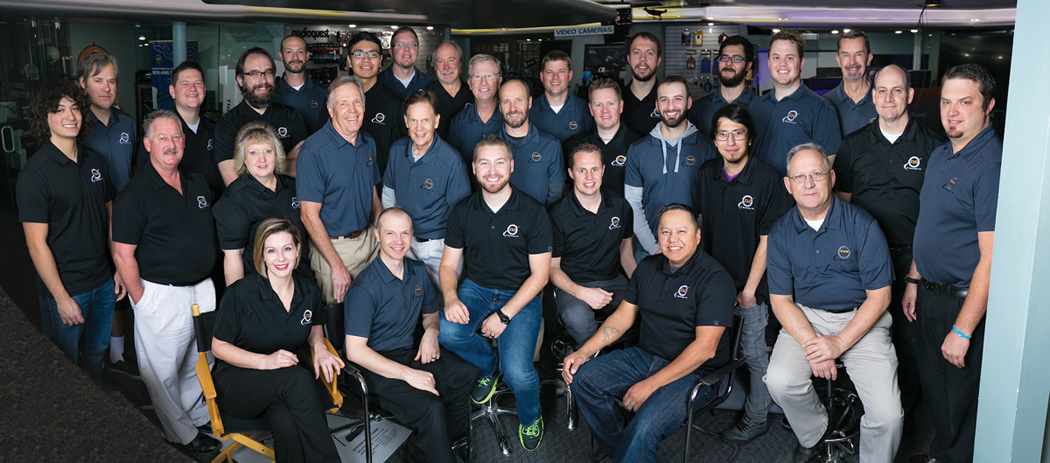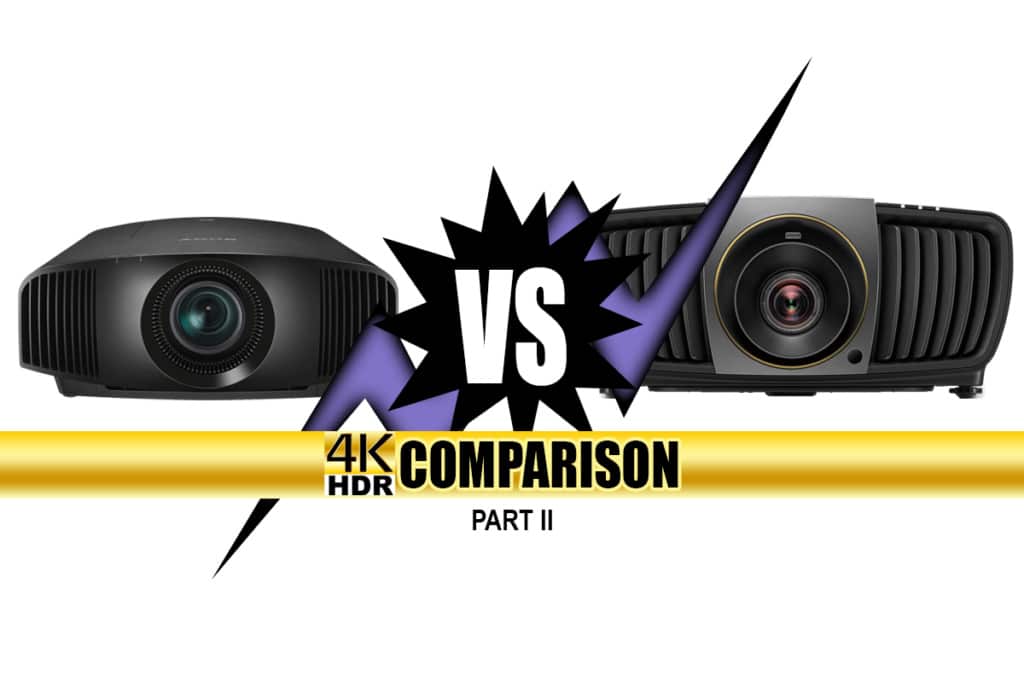AV Solutions, Home Theater
Sony VPL-VW295ES vs BenQ HT9060 (Part II)
If you haven’t read the 1st part of this blog post, we recommend reading it first.
Sony VPL-VW295ES vs BenQ HT9060 (Part I)
Color and HDR Performance
This is where it really starts to get interesting for us as we are all about the wide dynamic range of HDR and the wider color gamut that the new 4K UHD HDR Blu-ray discs provide. For the first time in our homes we can now enjoy the full range of color and brightness that the director intended. Since most commercial theaters do not yet have the 4K HDR capability, we can now enjoy movies with quality that is better than most local cinemas (and the popcorn is cheaper!). Seriously, when you see wide color gamut in 4K and HDR – the experience is amazing. In some cases, it is like seeing the movie (even if you have seen it before) for the first time. There is so much attention by the creative community to deliver a rich and technically correct movie that when it all comes together it is truly a rewarding experience for the viewer.

Sony color is called Triluminos, and was one of the first projector companies to show more than REC709 color. This adds a richness and depth to the image which is usually appreciated by most viewers. The color in the VPL-VW295ES and the VPL-VW695ES is specified by Sony as being able to do up to 127% of REC 709. That means, and measures, about 72% of DCI P3, which is mapped inside of the BT2020 color gamut as shown above. We were able to verify that the Sony’s do indeed do about 127% above REC 709, color which equates to about 58% of BT2020.

The BenQ HT9060 did indeed live up to its claim of 98% of the DCI P3 color gamut. What is really amazing, is that it did it without the use of a conventional cinema filter, which drops the light significantly. This is because of its use of pure RGB LEDs as the light source so no filters are required. In a normal lamp or laser projector, a cinema filter must be used to reach a wide color gamut. The problem is that it reduces the overall brightness of the projector so that its HDR capability is reduced. Not the case with the HT9060 – it has some of the best HDR and color we have seen.


What we discovered really surprised us. We expected the wide color gamut of the BenQ HT9060 to show some significant differences on scenes with large color pallets, but we did not expect to see such differences in the brightness curves that each manufacturer uses. This is Sony’s second generation HDR and BenQ’s first. Since BenQ was somewhat late coming to the game with HDR they have indicated it was because they wanted to get it right and spent over a year in its implementation. From what we are seeing, they did do a very good job.

Even though the brightness of the Sony measured 4-5 fc brighter, the BenQ looks brighter on most scenes. This is also because there is no single standard for how HDR is to be tone mapped. It is currently up to each manufacturer as to how they apply the HDR to their image. Both Sony and Epson have gone through several versions, but I have to say that this BenQ is very impressive. The color and the brightness of the BenQ HT9060 is, for most viewers who see it, a very impressive experience. We like what they have done with HDR tone mapping.


Image, Detail, & Sharpness
The other thing that attracted us to test the BenQ HT9060, besides the color, was the lens. A good, high quality lens can make a huge difference (just ask any cinematographer). Sony had improved their lens in 2017 which really helped to get an even-focused and reasonably sharp image. The question we had was how close could the BenQ come with its all-glass, 14-element, low dispersion coated lens. Even though it is not native true 4K (4096 X 2160), the DLP solution has looked remarkable considering it is UHD (3840 X 2160), using slightly larger pixels. We thought it would be close, but in reality it surprised us as to just how good the HT9060 lens really is. In addition to very sharp focus and contrast, there is almost no sign of color aberration on even the sharpest of white-on-black edges.

Without question, the BenQ has the better lens – and on most scenes the image simply looks sharper. How is that possible? Even though the Sony has alignment for the 3 SXRD panels it is never possible to get exactly perfect. Then send it though a lens that has some of its own color aberration (most lenses do) and the edges are not always razor sharp. The BenQ lens is probably the best projector lens we have seen. It is sharp in the center and edges with no real visible color fringing. This is due to the lens and the fact that there is only one chip so there is no alignment to be done in the image itself. Unlike most lenses this lens seems to be near perfect in its lack of color aberration or color fringing.



IMAX Experience
With two projectors this close it gave us the opportunity to compare the new IMAX Experience capability of the Sony. Imax has partnered with DTS and set new standards for both image quality and sound quality. Imax has taken their vast experience in large screen presentations and the technology they have developed to make the best image possible, with fine detail and lack of noise – which is no easy trick. One of the first titles to have the Imax Experience encoded into the disc is “Journey to the South Pacific”. This disc looks good on any 4K HDR display but we were pleasantly surprised to see the results on the Sony which has the special processing to take full advantage of this technology.




This was a great discovery and now we hope that more Imax Enhanced releases will come forth. According to Sony, there will be full length feature films released in this format.It definitely makes a difference and gives Sony the edge when it comes to Imax Enhanced viewing. It was so interesting to see first hand, as it was not just sharpness or edge processing, but a real difference in the amount of fine detail and texture in images.
Other Features
Before you make your final conclusions, you may want to check out our YouTube video that also goes over fan noise, gaming response and speed, CinemaScope, and Wide Aspect Capability.Plus, you’ll be able to playback of video.However, please be aware that, if you don’t have a monitor capable of HDR, YouTube will automatically detect that and down convert the video to SDR – which makes the color and contrast incorrect (almost looks like a raw log file). For example, on the opening scene with our logo, in SDR, the background appears to be gray, but in HDR it is white. As of today, the video has not been fully processed by YouTube with its HDR color in 4K, but here’s the video for now and hopefully YouTube will process the full thing soon!
Final Thoughts & Theo Charts
So which is the best projector? People always ask us that question. The answer is never that easy because it also depends on your budget and application. To help with this process, we have created the Theo Charts, which allow you to visually see the strengths and weaknesses of each projector. Notice the right half is all about image quality, and the left half is about how practical it is for your application. Some people would rather replace lamps knowing that their initial investment for the level of quality they receive is lower. Others will have nothing but laser or Pure LED as they do not want to worry about changing lamps and color balance drift over time. Some are fine with a 98″ screen while others would prefer a 133 Cinemascope widescreen in their theater. The point is – feel free to call us. We have six full time sales people who can assist you. We do not have automated voice recordings during business hours, so you will always talk to a live person. We may have to call you back due to in-store customers, but call us – we should be able to help you. That is why we do these videos to help start the conversations. We’ve been doing this for over 65 years so please give us a try. We would love to talk with you!







